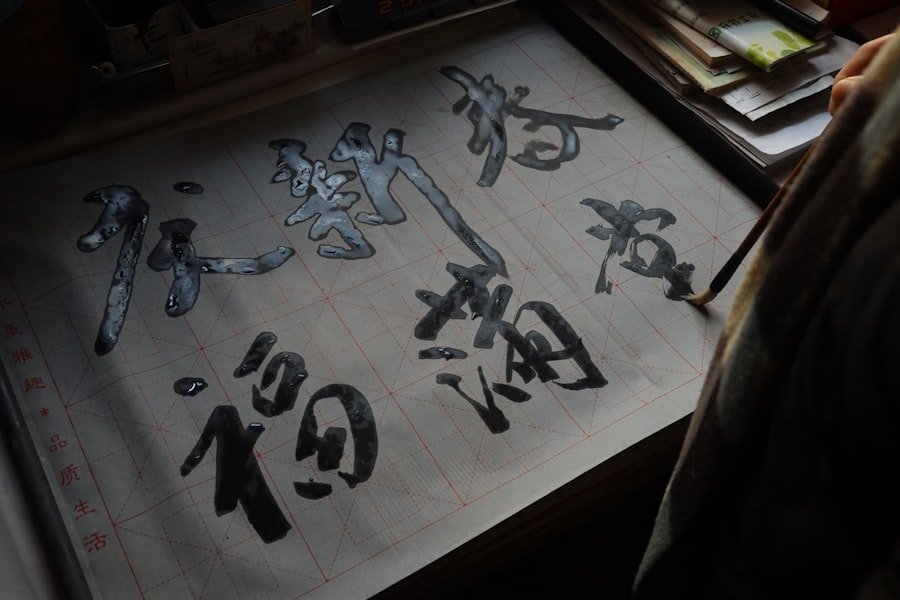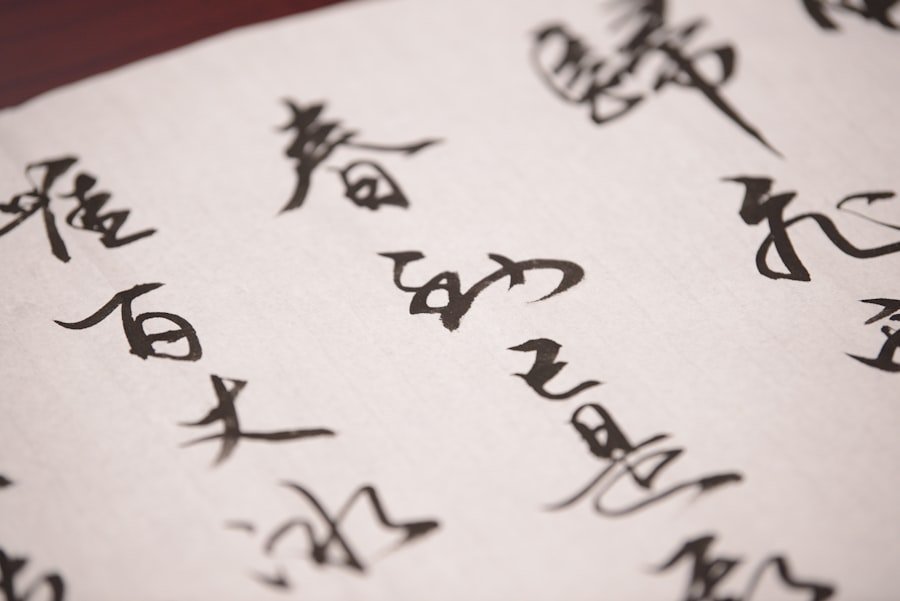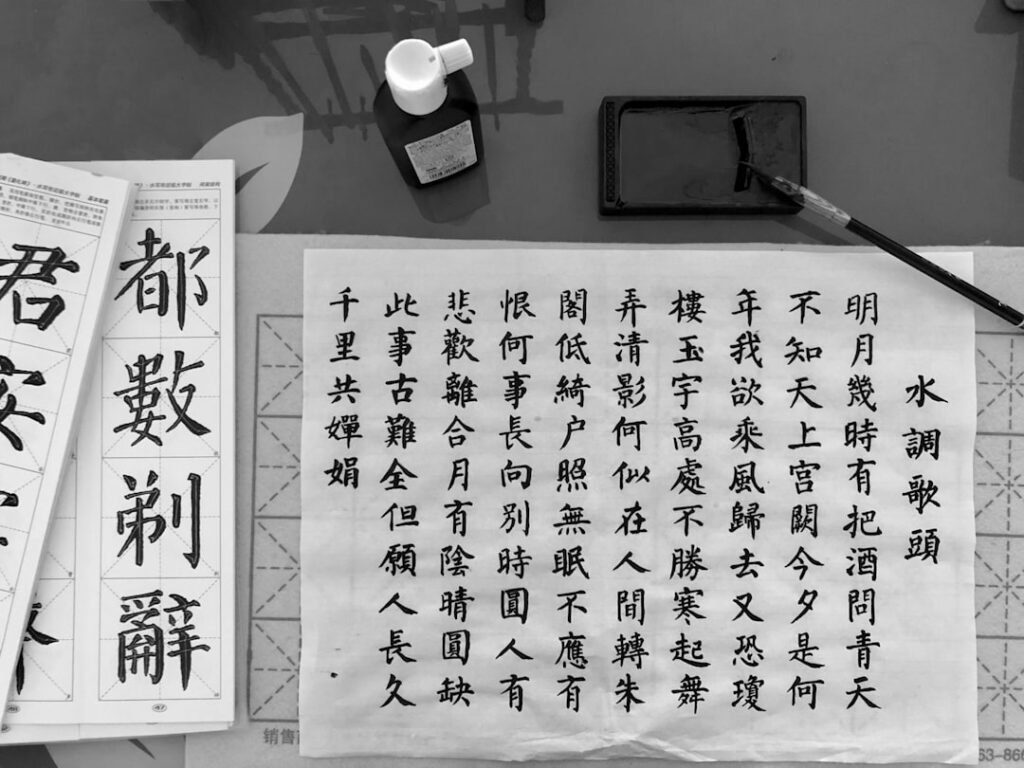Chinese calligraphy, an art form that has flourished for thousands of years, is deeply rooted in the cultural and historical fabric of China. Its origins can be traced back to the Shang Dynasty (c. 1600–1046 BCE), where inscriptions on oracle bones marked the beginning of written communication.
These early forms of writing were rudimentary, yet they laid the groundwork for the intricate and expressive art of calligraphy that would evolve over the centuries. As dynasties rose and fell, so too did the styles and techniques of calligraphy, reflecting the changing philosophies, aesthetics, and social structures of Chinese society. During the Han Dynasty (206 BCE–220 CE), calligraphy began to gain prominence as a respected art form.
Scholars and officials recognised its significance not only as a means of communication but also as a vehicle for personal expression and cultural identity. The invention of paper during the Han period further facilitated the spread of calligraphy, allowing it to reach a wider audience. Over time, various schools of thought emerged, each contributing to the development of distinct styles and techniques.
The Tang Dynasty (618–907 CE) is often regarded as the golden age of Chinese calligraphy, with renowned masters such as Wang Xizhi and Yan Zhenqing setting standards that continue to influence practitioners today. Master the art of Chinese calligraphy. Enroll now at the LC Chinese School in Oslo.
Table of Contents
ToggleSummary
- Chinese calligraphy has a rich history dating back thousands of years, with its roots in ancient Chinese writing systems.
- Chinese calligraphy holds great significance in Chinese culture, being considered a form of art, meditation, and self-expression.
- The five major scripts of Chinese calligraphy are Seal Script, Clerical Script, Regular Script, Running Script, and Cursive Script, each with its own unique characteristics.
- Seal Script is known for its square, angular characters, while Clerical Script is more structured and formal in appearance.
- Chinese calligraphy has evolved over time, with each script influencing art and design, and continues to be a popular practice for those seeking to learn and master this ancient art form.
The Importance of Chinese Calligraphy in Chinese Culture
Chinese calligraphy is more than just an artistic endeavour; it is a profound expression of Chinese culture and philosophy. It embodies the principles of harmony, balance, and beauty that are central to Chinese aesthetics. The act of writing is seen as a meditative practice, allowing the calligrapher to connect with their inner self while simultaneously engaging with the rich history and traditions of their culture.
Each stroke carries meaning, not only in its visual representation but also in its emotional resonance, making calligraphy a deeply personal and spiritual experience. Moreover, calligraphy serves as a bridge between generations, preserving the wisdom and values of ancient scholars while adapting to contemporary contexts. It is often used in important cultural ceremonies, such as weddings and festivals, where beautifully crafted characters are displayed to convey blessings and good fortune.
In this way, calligraphy transcends mere aesthetics; it becomes a vital part of social rituals and communal identity. The reverence for this art form is evident in its inclusion in educational curricula, where students learn not only the technical skills but also the philosophical underpinnings that inform their practice.
The Five Major Scripts of Chinese Calligraphy: An Overview

Chinese calligraphy encompasses a variety of scripts, each with its own unique characteristics and historical significance. The five major scripts—Seal Script, Clerical Script, Regular Script, Running Script, and Cursive Script—represent different stages in the evolution of Chinese writing. Each script reflects distinct aesthetic values and practical applications, showcasing the versatility and richness of this art form.
Seal Script, one of the oldest forms, is characterised by its intricate and stylised characters that often resemble pictographs. It was primarily used for official seals and inscriptions on bronze vessels. Clerical Script emerged during the Han Dynasty as a more practical writing style for administrative purposes.
Regular Script, developed later, became the standard form for printed texts due to its clarity and legibility. Running Script offers a more fluid and expressive style that allows for greater speed in writing, while Cursive Script is known for its spontaneous and free-flowing strokes. Together, these scripts illustrate the dynamic nature of Chinese calligraphy and its ability to adapt to changing needs over time.
The Structure and Characteristics of Seal Script
Seal Script (篆书), with its origins in ancient China, is distinguished by its elaborate and ornate characters. This script is often associated with official seals used by emperors and high-ranking officials, which adds to its historical significance. The characters in Seal Script are typically composed of rounded shapes and intricate lines that can appear almost abstract to the untrained eye.
This complexity requires a high level of skill and precision from the calligrapher, making it a challenging yet rewarding style to master. The structure of Seal Script is characterised by its use of both pictographic elements and phonetic components. Many characters retain their original meanings from ancient times, while others have evolved into more stylised forms.
The beauty of Seal Script lies in its ability to convey depth and emotion through its visual complexity. Calligraphers often spend years perfecting their technique in this script, as it demands not only technical proficiency but also an understanding of historical context and cultural significance.
The Structure and Characteristics of Clerical Script
Clerical Script (隶书) emerged during the Han Dynasty as a response to the need for a more practical writing style for administrative purposes. This script is characterised by its clear and straightforward strokes, making it easier to read than its predecessor, Seal Script. The characters are typically more rectangular in shape, with pronounced horizontal strokes that lend a sense of stability and order to the writing.
One notable feature of Clerical Script is its use of “flying white” strokes—short, upward flicks at the end of certain characters that add a dynamic quality to the writing. This script was widely used for official documents and inscriptions during its peak, reflecting the bureaucratic nature of Han society. As such, it played a crucial role in shaping the administrative practices of subsequent dynasties.
While Clerical Script may lack some of the ornate beauty found in Seal Script, its clarity and efficiency have made it an enduring choice for practical writing throughout history.
The Structure and Characteristics of Regular Script

Regular Script (楷书) represents a significant evolution in Chinese calligraphy, emerging during the late Han Dynasty and becoming standardised during the Tang Dynasty. This script is characterised by its balanced proportions and clear structure, making it highly legible and suitable for printed texts. Regular Script serves as the foundation for modern Chinese writing, with many contemporary fonts derived from its principles.
The structure of Regular Script is defined by its square shapes and even spacing between characters. Each stroke is executed with precision, allowing for a harmonious flow that enhances readability. Calligraphers often emphasise the importance of balance between thick and thin strokes, creating a visual rhythm that captivates viewers.
Regular Script is not only functional but also aesthetically pleasing; it embodies the ideals of clarity and order that are central to Chinese culture. As such, it remains a popular choice for both formal documents and artistic expression.
The Structure and Characteristics of Running Script
Running Script (行书) offers a more fluid alternative to Regular Script, allowing calligraphers to write with greater speed while maintaining legibility. This script emerged during the late Han Dynasty as a response to the practical needs of scholars who required a quicker method for note-taking and correspondence. Running Script retains many features of Regular Script but introduces a more cursive style that connects characters through flowing strokes.
The structure of Running Script is characterised by its dynamic movement; strokes often blend into one another, creating a sense of continuity that reflects the natural rhythm of writing. While it prioritises speed over strict adherence to formality, skilled practitioners can achieve remarkable beauty through careful control of their brushwork. Running Script embodies spontaneity and expressiveness, allowing calligraphers to infuse their personality into their work while still adhering to traditional principles.
The Structure and Characteristics of Cursive Script
Cursive Script (草书) represents the most free-spirited form of Chinese calligraphy, characterised by its rapid execution and highly stylised characters. This script allows for maximum expression and creativity, often sacrificing legibility for artistic flair. Cursive Script emerged during the Han Dynasty as an informal writing style used for personal correspondence and artistic expression.
The structure of Cursive Script is defined by its sweeping strokes and fluid connections between characters. Calligraphers often employ exaggerated curves and loops, resulting in characters that can appear almost abstract at times. While this script may be challenging for those unfamiliar with Chinese characters, it offers an exhilarating opportunity for artists to explore their creativity without constraints.
Cursive Script embodies the essence of spontaneity in calligraphy; it invites practitioners to embrace their individuality while honouring centuries-old traditions.
The Evolution of Chinese Calligraphy Scripts Over Time
The evolution of Chinese calligraphy scripts reflects broader changes in Chinese society, culture, and technology throughout history. From the intricate designs of Seal Script to the practicality of Regular Script, each style has emerged in response to specific needs within society. As literacy rates increased and printing technology advanced during the Tang Dynasty, there was a growing demand for clear and accessible writing styles that could be easily reproduced.
The transition from one script to another often mirrored shifts in philosophical thought as well; for instance, Confucian ideals emphasised orderliness and clarity in communication, which influenced the development of Regular Script. Conversely, periods marked by artistic flourishing saw a resurgence in more expressive styles like Cursive Script. This interplay between practicality and artistry has shaped not only how Chinese characters are written but also how they are perceived within cultural contexts.
The Influence of Chinese Calligraphy on Art and Design
Chinese calligraphy has had a profound impact on various forms of art and design beyond traditional writing practices. Its aesthetic principles have inspired painters, sculptors, architects, and graphic designers alike throughout history. The fluidity and rhythm inherent in calligraphic strokes can be seen reflected in brush paintings where movement captures both nature’s essence and human emotion.
In contemporary design contexts, elements derived from calligraphy are often integrated into logos or branding materials to evoke cultural authenticity or convey elegance. The interplay between textural qualities found within different scripts adds depth to visual compositions while honouring traditional craftsmanship. As global interest in Chinese culture continues to grow, so too does appreciation for this unique art form’s ability to transcend language barriers through visual expression.
Learning and Practising Chinese Calligraphy: Tips and Techniques
For those interested in delving into the world of Chinese calligraphy, there are several tips and techniques that can enhance your learning experience. First and foremost is understanding the importance of proper brush technique; mastering grip control allows for greater precision when executing strokes. Practising basic strokes repeatedly will build muscle memory essential for developing fluidity over time.
Additionally, studying classical works by renowned masters can provide invaluable insights into stylistic nuances while inspiring personal creativity within your practice. Joining classes or workshops led by experienced instructors can also facilitate growth through constructive feedback tailored specifically towards individual needs. At LC Chinese School in Oslo, we offer specialised courses focused on Chinese calligraphy that cater to all skill levels—from beginners eager to learn foundational techniques to advanced practitioners seeking refinement in their artistry.
Our experienced instructors guide students through various scripts while fostering an appreciation for both historical context and contemporary relevance within this timeless art form. In conclusion, Chinese calligraphy stands as a testament to centuries-old traditions that continue shaping cultural identity today—an art form rich with history yet ever-evolving alongside modern influences. Whether you are drawn by its aesthetic beauty or wish to explore deeper philosophical meanings behind each stroke—there has never been a better time than now to embark on your journey into this captivating world at LC Chinese School!
Master the art of Chinese calligraphy. Enroll now at the LC Chinese School in Oslo.







